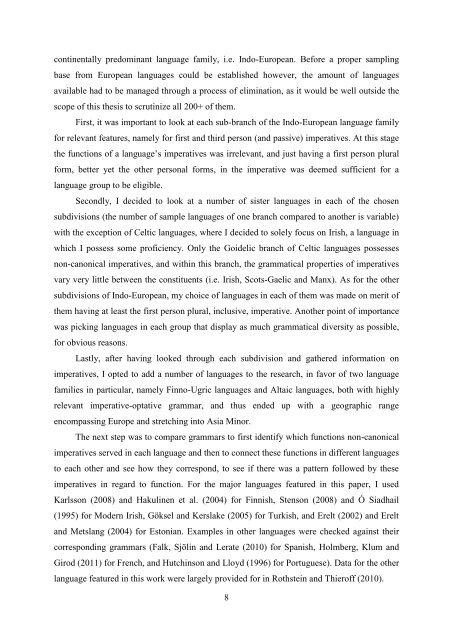The function of non-canonical imperatives in the languages of Europe
The function of non-canonical imperatives in the languages of Europe
The function of non-canonical imperatives in the languages of Europe
You also want an ePaper? Increase the reach of your titles
YUMPU automatically turns print PDFs into web optimized ePapers that Google loves.
cont<strong>in</strong>entally predom<strong>in</strong>ant language family, i.e. Indo-<strong>Europe</strong>an. Before a proper sampl<strong>in</strong>g<br />
base from <strong>Europe</strong>an <strong>languages</strong> could be established however, <strong>the</strong> amount <strong>of</strong> <strong>languages</strong><br />
available had to be managed through a process <strong>of</strong> elim<strong>in</strong>ation, as it would be well outside <strong>the</strong><br />
scope <strong>of</strong> this <strong>the</strong>sis to scrut<strong>in</strong>ize all 200+ <strong>of</strong> <strong>the</strong>m.<br />
First, it was important to look at each sub-branch <strong>of</strong> <strong>the</strong> Indo-<strong>Europe</strong>an language family<br />
for relevant features, namely for first and third person (and passive) <strong>imperatives</strong>. At this stage<br />
<strong>the</strong> <strong>function</strong>s <strong>of</strong> a language’s <strong>imperatives</strong> was irrelevant, and just hav<strong>in</strong>g a first person plural<br />
form, better yet <strong>the</strong> o<strong>the</strong>r personal forms, <strong>in</strong> <strong>the</strong> imperative was deemed sufficient for a<br />
language group to be eligible.<br />
Secondly, I decided to look at a number <strong>of</strong> sister <strong>languages</strong> <strong>in</strong> each <strong>of</strong> <strong>the</strong> chosen<br />
subdivisions (<strong>the</strong> number <strong>of</strong> sample <strong>languages</strong> <strong>of</strong> one branch compared to ano<strong>the</strong>r is variable)<br />
with <strong>the</strong> exception <strong>of</strong> Celtic <strong>languages</strong>, where I decided to solely focus on Irish, a language <strong>in</strong><br />
which I possess some pr<strong>of</strong>iciency. Only <strong>the</strong> Goidelic branch <strong>of</strong> Celtic <strong>languages</strong> possesses<br />
<strong>non</strong>-ca<strong>non</strong>ical <strong>imperatives</strong>, and with<strong>in</strong> this branch, <strong>the</strong> grammatical properties <strong>of</strong> <strong>imperatives</strong><br />
vary very little between <strong>the</strong> constituents (i.e. Irish, Scots-Gaelic and Manx). As for <strong>the</strong> o<strong>the</strong>r<br />
subdivisions <strong>of</strong> Indo-<strong>Europe</strong>an, my choice <strong>of</strong> <strong>languages</strong> <strong>in</strong> each <strong>of</strong> <strong>the</strong>m was made on merit <strong>of</strong><br />
<strong>the</strong>m hav<strong>in</strong>g at least <strong>the</strong> first person plural, <strong>in</strong>clusive, imperative. Ano<strong>the</strong>r po<strong>in</strong>t <strong>of</strong> importance<br />
was pick<strong>in</strong>g <strong>languages</strong> <strong>in</strong> each group that display as much grammatical diversity as possible,<br />
for obvious reasons.<br />
Lastly, after hav<strong>in</strong>g looked through each subdivision and ga<strong>the</strong>red <strong>in</strong>formation on<br />
<strong>imperatives</strong>, I opted to add a number <strong>of</strong> <strong>languages</strong> to <strong>the</strong> research, <strong>in</strong> favor <strong>of</strong> two language<br />
families <strong>in</strong> particular, namely F<strong>in</strong>no-Ugric <strong>languages</strong> and Altaic <strong>languages</strong>, both with highly<br />
relevant imperative-optative grammar, and thus ended up with a geographic range<br />
encompass<strong>in</strong>g <strong>Europe</strong> and stretch<strong>in</strong>g <strong>in</strong>to Asia M<strong>in</strong>or.<br />
<strong>The</strong> next step was to compare grammars to first identify which <strong>function</strong>s <strong>non</strong>-ca<strong>non</strong>ical<br />
<strong>imperatives</strong> served <strong>in</strong> each language and <strong>the</strong>n to connect <strong>the</strong>se <strong>function</strong>s <strong>in</strong> different <strong>languages</strong><br />
to each o<strong>the</strong>r and see how <strong>the</strong>y correspond, to see if <strong>the</strong>re was a pattern followed by <strong>the</strong>se<br />
<strong>imperatives</strong> <strong>in</strong> regard to <strong>function</strong>. For <strong>the</strong> major <strong>languages</strong> featured <strong>in</strong> this paper, I used<br />
Karlsson (2008) and Hakul<strong>in</strong>en et al. (2004) for F<strong>in</strong>nish, Stenson (2008) and Ó Siadhail<br />
(1995) for Modern Irish, Göksel and Kerslake (2005) for Turkish, and Erelt (2002) and Erelt<br />
and Metslang (2004) for Estonian. Examples <strong>in</strong> o<strong>the</strong>r <strong>languages</strong> were checked aga<strong>in</strong>st <strong>the</strong>ir<br />
correspond<strong>in</strong>g grammars (Falk, Sjöl<strong>in</strong> and Lerate (2010) for Spanish, Holmberg, Klum and<br />
Girod (2011) for French, and Hutch<strong>in</strong>son and Lloyd (1996) for Portuguese). Data for <strong>the</strong> o<strong>the</strong>r<br />
language featured <strong>in</strong> this work were largely provided for <strong>in</strong> Rothste<strong>in</strong> and Thier<strong>of</strong>f (2010).<br />
8
















